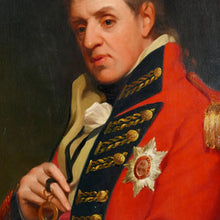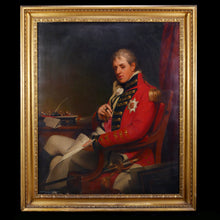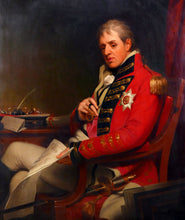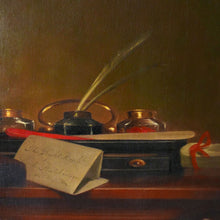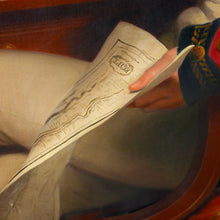General Sir John Hely-Hutchinson, 2nd Earl of Donoughmore, 1827
- Regular price
- £25,000
- Sale price
- £25,000
- Regular price
-
- Unit price
- /per
Adding product to your cart
Measurements: 150cm x 129cm
Provenance:
Colonel Hon. Henry Hely Hutchinson (1790-1844)
Harriet, Lady Hanmer (1826-1911)
Sir George Sitwell, 4th Bart., (1860-1943)
Sir Sacheverell Sitwell, 6th Bart., C.H. (1897-1988)
Oil on canvas. Three quarter length seated portrait, looking left, in British general officer’s uniform and wearing the star of the Order of the Bath, holding an eyeglass in the right hand and a map of Egypt in his left, reflecting his period of command in Egypt and his crucial role in securing the Rosetta Stone and other antiquities from the French at the capitulation of the Armée d' Orient in September 1801. The map inscribed, signed and dated along a contour line by the artist ‘Painted by W. Robinson after Phillips RA 1827’. Contained in its original gilt wood frame.
Read more
The present portrait was a private commission probably for the sitter’s nephew, Colonel the Hon. Henry Hely-Hutchinson at the time of his marriage to a Northamptonshire heiress, Harriet Wrightson of Weston Hall. The 2nd Earl of Donoughmore, as General Hely-Hutchinson was styled at the end of his life, never married and it was Henry’s older brother who was heir to the earldom. Henry, himself a Waterloo veteran, became lord of the manor at Weston Hall, where the present portrait was to remain for best part of the next 200 years. The portrait is based on a painting that the Prince Regent commissioned in 1811 from the Royal Academician Thomas Phillips (1770-1845) for the Royal Collection (where it remains RCIN 402776) in recognition of Hely-Hutchinson’s achievements in Egypt and in his role as a trusted advisor on political as well as domestic issues.
The painter of the present portrait William Robinson was a popular choice for portraits of national icons in the 1820s and 30s. Accordingly he was chosen by the United Services Club in Pall Mall to execute portraits of Moore of Corunna, Admiral Lord Nelson, the Duke of Wellington and King George III. Of General Hely-Hutchinson’s many services, his success in securing the Rosetta Stone for George III and the British Museum must be ranked as his most enduring. This came about following the Battle of Alexandria (21 March 1801), where his superior Sir Ralph Abercromby was mortally wounded. Taking command of the British expeditionary force in Egypt, Hely-Hutchinson left Major-General Eyre Coote to besiege Alexandria into which the French under Jacques-François de Menou hard retreated while he pressed home operations in the direction of Cairo. Meanwhile an Anglo-Indian expeditionary force had landed at near Cairo with the intention of besieging that city. At their approach French archaeologists (Savants) from the Institut d’Egypte carried the Stone from Cairo to Alexandria, where it joined other pieces the French had stowed away.
When the French were finally bottled up in Alexandria and Cairo, and cut off from France by the Royal Navy’s dominance over the Mediterranean, Hely-Hutchinson demanded the hand over of the antiquities, foremost among them the Stone, as a preliminary to discussing any form of surrender. The French initially balked, claiming that the antiquities belonged to the Institut d’Egypte, but acceded after Cairo fell on the 27 June and Alexandria capitulated on August 30. Hutchinson immediately dispatched a team of English scholars to monitor the French compliance with their promise and to ascertain what pieces of history the British would claim. The head of this expedition was Edward Daniel Clarke, who searched the collections in Alexandria and found many artefacts that the French had not revealed. Hutchinson claimed all materials as property of the British Crown under Article XVI of the treaty of capitulation. In reward for his military successes the Ottoman Sultan Selim III made him a Knight, 1st Class, of the Order of the Crescent. ASJ24






